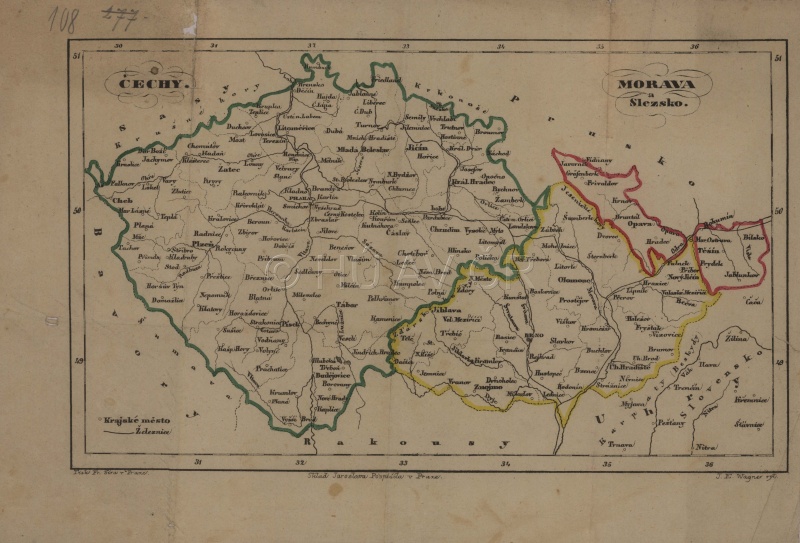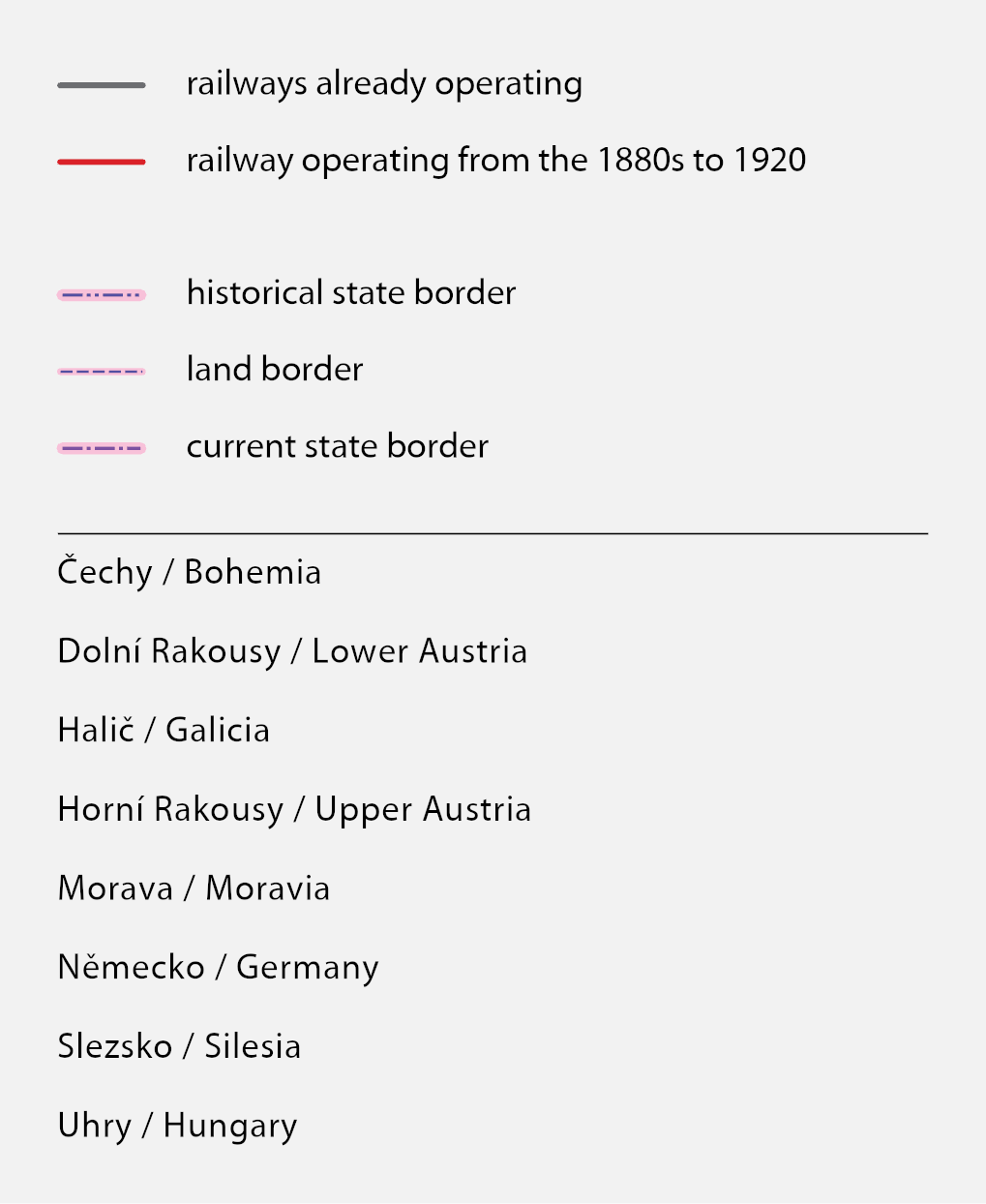Railway construction in the first half of the 19th century
Two horsecars built on our territory at the turn of the 1820s were the first railways. The track from Linz to České Budějovice (following up the Vltava River shipping) transported salt from the Salzkammergut and the track from Lány to Prague transported wood. The first steam train arrived in Brno in 1839 and then in Lipník nad Bečvou in 1841. Prague was connected with Vienna via Olomouc in 1845 and subsequently, this Northern State Railway was prolonged to Podmokly (today Děčín) and the border with Saxony in 1851. In the meantime, the Emperor Ferdinand Northern Railway was prolonged to Bohumín (with continuation to the salt mines at Krakow) in 1847 and a railway junction between Brno and Česká Třebová was built in 1849.

Map of the Czech Lands with marking of the railway network (ca. the 1850s). Map Collection of the Institute of History, CAS. Display map
References
Geschichte der Eisenbahnen der Österreichisch-Ungarischen Monarchie. I–VI. Teschen 1898;
Štěpán, M.: Přehledné dějiny československých železnic. Praha 1958;
Hons, J.: Dějiny dopravy na území ČSSR. Bratislava 1975;
Hlavačka, M.: Dějiny dopravy v českých zemích v období průmyslové revoluce. Praha 1991;
Krejčiřík, M.: Po stopách našich železnic. Praha 1991;
Hlavačka, M.: Železnice Čech, Moravy a Slezska. Praha 1995.

This work is licensed under a Creative Commons BY-NC-ND 4.0
Development of the railway network until the mid-1860
After 1850, the neo-absolutist state saw the importance of a modern communication system and started to support the construction of new state railways and buy the existing private railways. However, it soon reached financial limits. Therefore, at the end of 1854, the railway construction was moved to private hands and supported by state guarantees. As a result, 624 km of railways were built from private resources in the Czech Lands by the mid-1860s, the most important being the Pardubice-Liberec railway, which continued to Zittau, in 1859, the Prague-Plzeň railway, which continued to the border at Domažlice, in 1862, the Turnov-Kralupy railway in 1865 and several so-called coal railways (Ústí-Teplice, Buštěhrad, Brno-Rosice and other).

Map of the Czech Lands with marking of the railway network (ca. the 1850s). Map Collection of the Institute of History, CAS. Display map
References
Geschichte der Eisenbahnen der Österreichisch-Ungarischen Monarchie. I–VI. Teschen 1898;
Štěpán, M.: Přehledné dějiny československých železnic. Praha 1958;
Hons, J.: Dějiny dopravy na území ČSSR. Bratislava 1975;
Hlavačka, M.: Dějiny dopravy v českých zemích v období průmyslové revoluce. Praha 1991;
Krejčiřík, M.: Po stopách našich železnic. Praha 1991;
Hlavačka, M.: Železnice Čech, Moravy a Slezska. Praha 1995.

This work is licensed under a Creative Commons BY-NC-ND 4.0
Railway network development in the years 1867–1877
The biggest development of railway construction by private companies in the Czech Lands started during the economic boom following 1866 when the basic railway network was de facto completed. There were 10,000 km of railways built in the Habsburg Empire of which there were 3,260 km in the Czech Lands. Both the long-distance railways (the Emperor Franz Joseph Railway from Velenice to Cheb or a large network of the Austrian Northwestern Railway) and individual regional lines were constructed. They often followed up the previously built coal railways and ran beyond the borders of the empire (the Buštěhrad railway). This period ended after 1873 with a great economic crisis that hit the Austro-Hungarian Empire. After that, railway construction and operation was again nationalized.

Railway map of the Czech Lands (ca. 1875). Map Collection of the Institute of History, CAS. Display map
References
Geschichte der Eisenbahnen der Österreichisch-Ungarischen Monarchie. I–VI. Teschen 1898;
Štěpán, M.: Přehledné dějiny československých železnic. Praha 1958;
Hons, J.: Dějiny dopravy na území ČSSR. Bratislava 1975;
Hlavačka, M.: Dějiny dopravy v českých zemích v období průmyslové revoluce. Praha 1991;
Krejčiřík, M.: Po stopách našich železnic. Praha 1991;
Hlavačka, M.: Železnice Čech, Moravy a Slezska. Praha 1995.

This work is licensed under a Creative Commons BY-NC-ND 4.0
Construction of local railways in the late 19th and early 20th century
After the experience of the economic crisis, when private companies could not satisfy state and public interests, the state took the initiative again from the 1870s onwards, starting at its own expense to build and run the railways. Many private railways were nationalized, but part of the lines was still being built and operated by private companies. The basic rail network was significantly extended before the outbreak of World War I (from the original 3,800 km of lines in the late 1870s to 6,700 km in 1910) and supplemented mainly by so-called lower-order railways. They aimed to make regions not yet connected to the railways more accessible. However, most of the new local railways were low in profitability or even loss-making, contrasting with the newly introduced bus routes, significantly less expensive and more profitable. As a result, some of the newly built local railways were soon shut down.

Bruncík's Toponymic Map of the Kingdom of Bohemia with marking of railway network (ca. 1908). Map Collection of the Institute of History, CAS. Display map
References
Geschichte der Eisenbahnen der Österreichisch-Ungarischen Monarchie. I–VI. Teschen 1898;
Štěpán, M.: Přehledné dějiny československých železnic. Praha 1958;
Hons, J.: Dějiny dopravy na území ČSSR. Bratislava 1975;
Hlavačka, M.: Dějiny dopravy v českých zemích v období průmyslové revoluce. Praha 1991;
Krejčiřík, M.: Po stopách našich železnic. Praha 1991;
Hlavačka, M.: Železnice Čech, Moravy a Slezska. Praha 1995;
Pavlíček, S.: Naše lokálky. Praha 2003;
Semotanová, E. – Cajthaml, J. a kol.: Akademický atlas českých dějin. Praha 2014, 2. akt. vydání 2016.

This work is licensed under a Creative Commons BY-NC-ND 4.0

